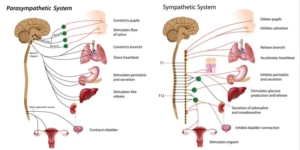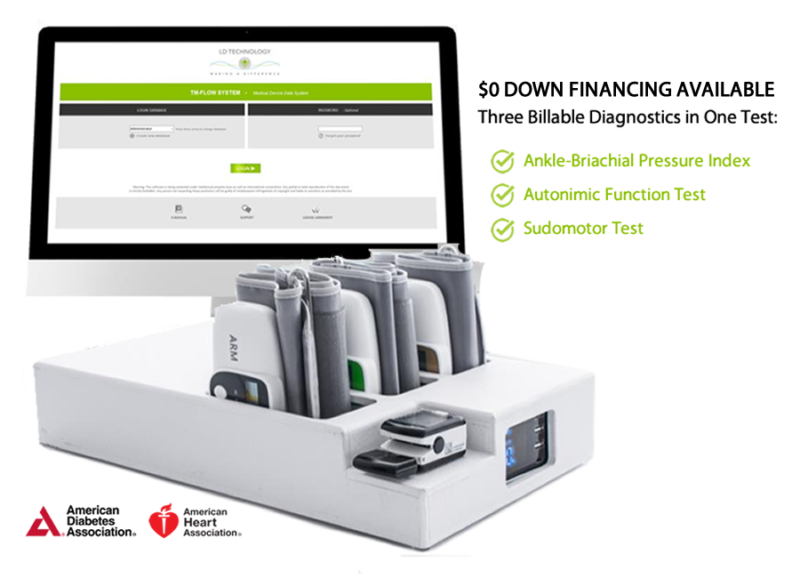Frequently Asked Questions
The TM Flow device offers numerous benefits for medical practices, including non-invasive and accurate testing, early detection of autonomic and arterial dysfunctions, and comprehensive diagnostics that reduce the overall cost of patient care. Additionally, the device’s tests are easy to bill with multi-code diagnostics, making it a valuable investment for enhancing patient care and optimizing practice efficiency. It also supports compliance with standards of care recommended by leading health organizations.
Yes, the TM Flow device is covered by Medicare and most private pay carriers. Specific CPT codes, such as 95921 for cardiovagal innervation and 93923 for ankle-brachial pressure index, ensure that the diagnostics are easy to bill. Coverage and reimbursements may vary depending on the Medicare locality, but the comprehensive diagnostics offered by the TM Flow device are widely recognized and supported by insurance providers.
Autonomic nervous system testing is crucial for diabetes and cardiovascular patients because it helps in the early detection of autonomic neuropathy, which is a common complication in these conditions. Early detection through ANS testing allows for timely intervention and management, reducing the risk of further complications. The American Diabetes Association recommends ANS testing as a standard of care for patients with Type 1 and Type 2 diabetes, highlighting its importance in effective diabetes management.
The TM Flow device is an advanced, non-invasive diagnostic tool designed to perform a series of tests that aid in the identification and early detection of autonomic nervous system (ANS) and arterial dysfunctions. It provides quantitative assessments of the ANS, helping to distinguish between early and late stages of autonomic neuropathy. The TM Flow device is particularly valuable for cardiovascular and diabetic autonomic neuropathy (DAN) testing, making it an essential tool in diabetes management and cardiovascular assessments.
https://www.youtube.com/watch?v=xq8uULMDmYw he autonomic nervous system (ANS) is the system that controls the majority of involuntary or ‘automatic functions of the body. AUTONOMIC = AUTOMATIC “The autonomic nervous system regulates the body’s responses without consciously thinking such as breathing, heart rate, blood pressure, digestion, sexual arousal & many other biochemical processes. The autonomic nervous system sends signals through nerves pathways to control & regulate most organ function such as the heart, lungs, kidney’s etc. The autonomic nervous system is a very complex system of nerves starting in the brain and sent via the spinal cord through peripheral nerves that extend to all parts of the body.” There are two distinct divisions of the autonomic nervous system. These branches are known as the parasympathetic and the system sympathetic system.  Parasympathetic System “The Parasympathetic System is commonly associated with the “rest and digest” responses – those bodily actions needed to restore energy and rest the body. For example, chewing food triggers the Parasympathetic Nervous System to increase production of saliva and to increase digestion in the gut. The Parasympathetic System also increases gallbladder function, which assists in the digestive process.” Sympathetic System The Sympathetic System is commonly associated with the “fight or flight” responses – those bodily reactions that you need to respond quickly in an emergency. When faced with a life threatening situation, your human instinct takes over and you either fight the danger you are facing, or you take flight and run away from the danger. Your Sympathetic System allows your body to do this rapidly. For example, in the face of danger, your Sympathetic System will cause bronchial dilation – this allows you to breathe better while you are fighting or running away from the dangerous situation. Likewise, your heart will beat stronger and faster, also prepping the body to fight or take flight. Disorders of the ANS can affect any system of the body They can originate in the peripheral or central nervous system and may be primary or secondary to other disorders. Symptoms suggesting autonomic dysfunction include orthostatic hypotension, heat intolerance, nausea, constipation, urinary retention or incontinence, nocturia, impotence, and dry mucous membranes. If a patient has symptoms suggesting autonomic dysfunction, cardiovagal, adrenergic, and sudomotor tests are usually done to help determine severity and distribution of the dysfunction.
Parasympathetic System “The Parasympathetic System is commonly associated with the “rest and digest” responses – those bodily actions needed to restore energy and rest the body. For example, chewing food triggers the Parasympathetic Nervous System to increase production of saliva and to increase digestion in the gut. The Parasympathetic System also increases gallbladder function, which assists in the digestive process.” Sympathetic System The Sympathetic System is commonly associated with the “fight or flight” responses – those bodily reactions that you need to respond quickly in an emergency. When faced with a life threatening situation, your human instinct takes over and you either fight the danger you are facing, or you take flight and run away from the danger. Your Sympathetic System allows your body to do this rapidly. For example, in the face of danger, your Sympathetic System will cause bronchial dilation – this allows you to breathe better while you are fighting or running away from the dangerous situation. Likewise, your heart will beat stronger and faster, also prepping the body to fight or take flight. Disorders of the ANS can affect any system of the body They can originate in the peripheral or central nervous system and may be primary or secondary to other disorders. Symptoms suggesting autonomic dysfunction include orthostatic hypotension, heat intolerance, nausea, constipation, urinary retention or incontinence, nocturia, impotence, and dry mucous membranes. If a patient has symptoms suggesting autonomic dysfunction, cardiovagal, adrenergic, and sudomotor tests are usually done to help determine severity and distribution of the dysfunction.
RSS FEED
- The TM Flow is a highly reimbursable diagnostic in Portland, OR
- Pain Clinics in Albuquerque, NM Adopt the TM Flow as Gold Standard
- Neuropathy in Philadelphia, PA can be detected with the TM Flow device
- Pain Management Clinics in Dallas, TX are Using the TM Flow to Diagnose Symptoms
- Unlocking the Potential of ANS Testing: Insights for Healthcare Providers
- Neuropathy clinics in Savanah, GA use the TM Flow
- Come to Charleston, WV to Get a TM Flow
- How the TM Flow will maximize your physician practice in Boise Idaho
- Doctors in Pittsburg, PA are using the TM Flow for the treatment of neuropathy
- Which Patients Require ANS Testing?
